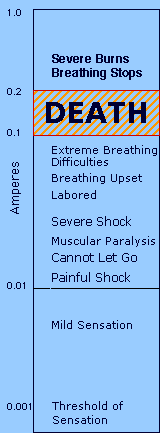The Fatal Current :
 Strange as it may seem, most fatal electric shocks happen to people who should know better. Here are some electro-medical facts that should make you think twice before taking that last chance.
Strange as it may seem, most fatal electric shocks happen to people who should know better. Here are some electro-medical facts that should make you think twice before taking that last chance.It's The Current That Kills :
Offhand it would seem that a shock of 10,000 volts would be more deadly than 100 volts. But this is not so! Individuals have been electrocuted by appliances using ordinary house currents of 110 volts and by electrical apparatus in industry using as little as 42 volts direct current. The real measure of shock's intensity lies in the amount of current (amperes) forced though the body, and not the voltage. Any electrical device used on a house wiring circuit can, under certain conditions, transmit a fatal current.
While any amount of current over 10 milliamps (0.01 amp) is capable of producing painful to severe shock, currents between 100 and 200 mA (0.1 to 0.2 amp) are lethal. Currents above 200 milliamps (0.2 amp), while producing severe burns and unconsciousness, do not usually cause death if the victim is given immediate attention. Resuscitation, consisting of artificial respiration, will usually revive the victim.
From a practical viewpoint, after a person is knocked out by an electrical shock it is impossible to tell how much current has passed through the vital organs of his body. Artificial respiration must be applied immediately if breathing has stopped.
The Physiological Effects of Electric Shock
The chart shows the physiological effects of various currents. Note that voltage is not a consideration. Although it takes voltage to make current flow, the amount of shock-current will vary, depending on the body resistance between the points of contact.
As shown in the chart, shock is relatively more severe as the current rises. For currents above 10 milliamps, muscular contractions are so strong that the victim cannot let go of the wire that is shocking him. At values as low as 20 milliamps, breathing becomes labored, finally ceasing completely even at values below 75 milliamps.As the current approaches 100 milliamps, ventricular fibrillation of the heart occurs - an uncoordinated twitching of the walls of the heart's ventricles which results in death. Above 200 milliamps, the muscular contractions are so severe that the heart is forcibly clamped during the shock. This clamping protects the heart from going into ventricular fibrillation, and the victim's chances for survival are good. |
Danger - Low Voltage
It is common knowledge that victims of high-voltage shock usually respond to artificial respiration more readily that the victims of low-voltage shock. The reason may be the merciful clamping of the heart, owing to the high current densities associated with high voltages. However, lest these details be misinterpreted, the only reasonable conclusion that can be drawn is that 75 volts are just as lethal as 750 volts.
The actual resistance of the body varies depending upon the points of contact and the skin condition (moist or dry). Between the ears, for example, the internal resistance (less the skin resistance) is only 100 ohms, while from hand to foot is closer to 500 ohms. The skin resistance may vary from 1000 ohms for wet skin to over 500,000 ohms for dry skin.






